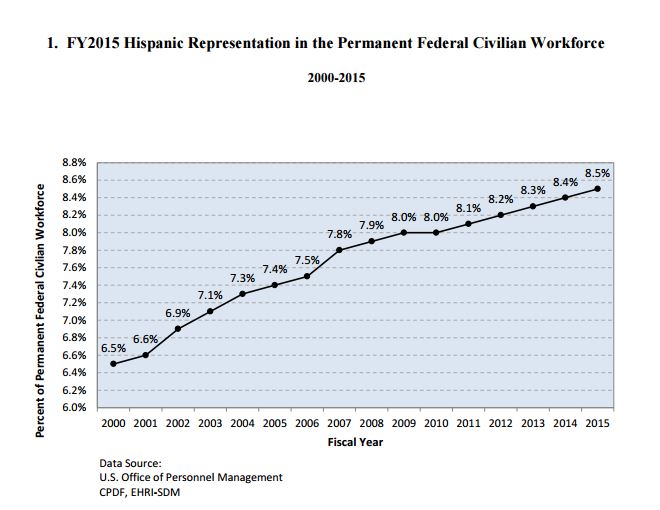
Another year, another tiny bump in federal Hispanic employment
Hispanics represented 8.5 percent of the permanent federal workforce in 2015, a 0.1 percent bump over fiscal 2014's numbers. Though 2015 marks the sixth consecutive...
Hispanics represented 8.5 percent of the federal workforce in fiscal 2015, another 0.1 percent bump over the previous year’s numbers.
It was the sixth consecutive year agencies have made modest increases in Hispanic representation within the permanent federal workforce, according to the Office of Personnel Management’s latest report on the topic. Hispanics also made up 7.5 percent of all permanent new hires to the federal workforce in 2015, consistent with 2014 numbers.
“The 0.1 percent per year is not sufficient,” Acting OPM Director Beth Cobert said during a Hispanic Employment Council meeting in Washington Oct. 13.

To that end, the Council said it would encourage agencies to get their leadership more involved in its work and would invite department chief human capital officers and chief learning officers to attend their meetings.
“We’re the ones who are sitting at the table saying this isn’t cutting the mustard,” said Zina Sutch, director of the Office of Diversity and Inclusion at OPM. “We’re sitting there saying, what have you done? Because one of the things that we hear from agencies is, ‘Well, we’ve done everything.’ And what we say is, let’s walk through [this.]”
OPM is also trying to find agencies who have seen some success in Hispanic hiring in recent years and will match them up with organizations who have made less progress.
“That’s why these meetings are two hours and sometimes go longer, because we’re dissecting what strategies they have implemented and then identifying what are the weaknesses in those strategies,” Sutch said at Thursday’s meeting. “If this isn’t working, then you need to change what you’re doing. You can’t keep doing what you’ve been doing for the last three to five years and expect your numbers to change.”
This is the 15th year OPM has issued a report on Hispanic hiring and employment in the federal workforce. In 2000, Hispanic permanent federal civilian employees represented 6.5 percent of the workforce. Since 2000, that percentage has incrementally increased — the largest increase being 0.3 percent between 2006 and 2007 — though the percentage remained flat at 8.0 percent in 2009 and 2010.
The Council said it’s also paying special attention to the number of Hispanic members in top leadership and executive positions.
Hispanics represented 4.4 percent of the Senior Executive Service, which remained flat between fiscal 2014 and 2015. Agencies also brought on fewer Hispanics to new SES positions in 2015. Just 15 Hispanics joined the SES in 2015, compared to 19 during the previous year.
The latest numbers on Hispanic representation within the Senior Executive Service are disappointing, the Council acknowledged. But Cobert said she’s anxious to see whether agencies make strides this year, as 2016 marks the implementation period to adopt pieces of President Barack Obama’s executive order to better recruit, retain and develop senior executives.
Agencies are starting to take a more targeted, strategic approach to talent management under the executive order, she said.
“Often as we know, folks look around and say, ‘Well, there’s nobody like me there, so therefore I’m less likely to be successful so why should I go through all this hassle of applying?'” Cobert said. “It’s all about how we break down that perception.”
Agencies hired fewer Hispanics to professional positions — 5.1 percent of all new hires in 2015 compared to 5.7 percent the year before. More Hispanics, 6.1 percent of all new hires, came on board to administrative positions in 2015 compared to 5.6 percent in 2014.
Nursing remains a popular profession for Hispanics in the federal workforce; agencies hired 504 Hispanic nurses in 2015. The largest percent of new hires was in the auditing occupation, where Hispanics made up nearly 29 percent of new hires to auditing positions last year.
The Council last December decided to set up a working group to study and ultimately propose how agencies can conduct a more comprehensive analysis of Hispanics in the federal workforce. The group finished a final proposal in April, which gives agencies until January 2017 to study their own barriers to Hispanic hiring.
But the Equal Employment Opportunity Commission wants to push that deadline back to January 2018.
“We really do need a tool that we can hand out with the memo so that agencies don’t feel like we’re just asking them to do something without providing them any kind of guidance,” Sutch said. “Giving us and them time to make sure that we’re providing them with good guidance that’s best practice … we’re really encouraged that that’s the date we’re going to set, January 2018.”
Yet many who sit on the Council are frustrated that the deadline may get pushed back. The tool and guidebook for agencies looked like as if it was almost finished, said Georgia Coffey, deputy assistant secretary for diversity and inclusion at the Veterans Affairs Department.
“The memo should have gone out,” she said. “It didn’t. And now it would be unfair to federal agencies to say ‘Oh by the way, you have to do this extensive barrier analysis on separations, hiring, etc. for this group of people.’ It is what it is.”
“I see the incremental increase in Hispanic representation from 2015 data, and I suspect it will still be a valid recommendation next year,” Coffey added.
Meanwhile, the RAND Corporation is finishing its own barrier analysis to Hispanic hiring in the Defense Department.
Obama last week signed a presidential memo aimed at guiding the national security workforce to diversify and strengthen their talent.
Copyright © 2025 Federal News Network. All rights reserved. This website is not intended for users located within the European Economic Area.
Nicole Ogrysko is a reporter for Federal News Network focusing on the federal workforce and federal pay and benefits.
Follow @nogryskoWFED






